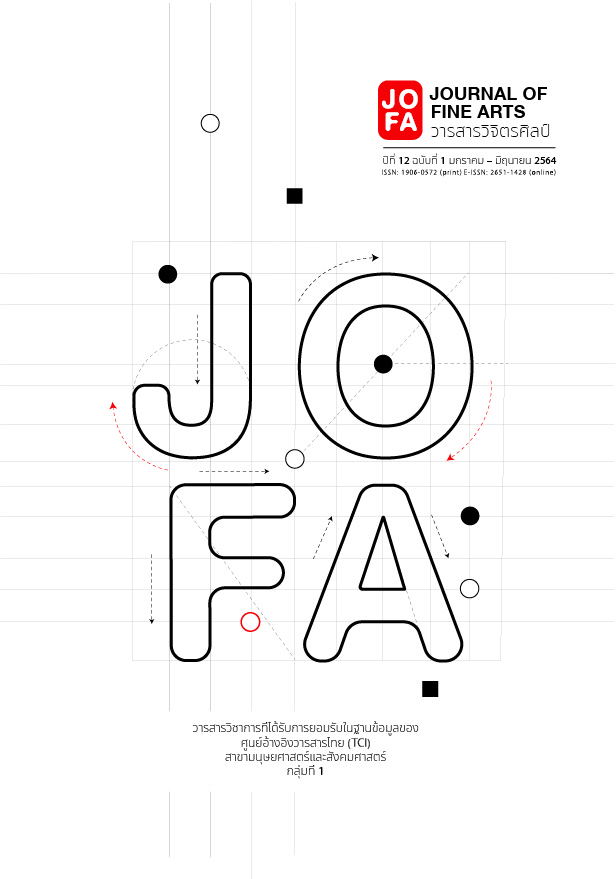Techniques in the Reign of King Rama III on the Murals inside the Ordination Hall of Wat Phra Chetuphon
Main Article Content
Abstract
The ordination hall of Wat Phra Chetuphon was constructed in accordance to the intention of King Rama III. Its murals are interesting in the aspect of themes and techniques. The murals show the themes that had never been painted before, such as Mahosot Jataka and 41 disciples (these themes replace the traditional themes, namely the Lord Buddha’s life, the last ten previous lives, Buddhist cosmology and the assembly of deities). From the research, it is found that the artisans inherited some techniques from the ancient tradition. For example, in the painting of Mahosot Jataka, the position of each scene was arranged by considering the place in which that scene took place. Another example is that the details on the lower walls are smaller than those of the upper walls: this shows the consideration of artisans towards the distance between the walls and watchers, as well as the importance of each scene. The two aforementioned techniques were used before the reign of King Rama III. However, the artisans of King Rama III created some new techniques. For instances, the scenes were painted continually on the four upper walls; the artisans gave importance on sceneries and architectures. Those new techniques were probably related to the inspirations from the foreign art, especially Chinese art, and to the huge size of the building.
Article Details
References
Chaiyapotpanit, A. “Itthiphon Silpa chin Nai Ngan Chittakam Baep Nok Yang Samai Ratchakan Ti 3. [Influence of Chinese decorative art on paintings of royal preference: King Rama III].” Master’s Thesis in Art History, Silpakorn University, 2004.
________. “Sen Sadaeng Raya Luangta Lae Saeng Ngao Nai Chittakam Samai Rattanakosin Ton Ton. [Perspective and Chiaroscuro in Murals of the Early Rattanakosin Period].”Academic talks on art history on the occasion of 72 years Emeritus Professor Santi Leksukhum, Ph.D., Bangkok, 2017.
China-history. “Qing Dynasty.” china-history. Accessed May 30, 2018. http://www.china-history.net/qing_painting_right.htm.
Chod Mai Het Rueang Patisangkhon Wat Phra Si Rattana Satsadaram Khrang Ratchakan Ti III. [Archives of Renovating Wat Phra Si Rattana Satsadaram in the Reign of King Rama III]. Bangkok: Sophon Phiphatthanako, 1922.
Crawfurd, J. Journal of an Embassy from the Governor – General of India to the Courts of Saim and Cochin China. London: Oxford University Press, 1967.
Fine Arts Department, National Archives of Thailand. Chod Mai Het Kan Anurak Krung Rattanakosin. [Archives of Rattanakosin Conservation]. Bangkok: Fine Arts Department, 1982.
H.W. and Dora Jane Janson, Translated by Amontat, Kitima. Prawat Chittakam (Chak Tham Chueng Samai Patchuban). [The story of painting]. Bangkok: Department of Curriculum and Instruction Development, 1990.
Hearn, Maxwell K. “The Qing Dynasty (1644–1911): Painting.” Metmuseum. Accessed May 30, 2018. https://www.metmuseum.org/toah/hd/qing_1/hd_qing_1.htm.
Jonathan5485. “Mr. and Mrs. Andrews by Thomas Gainsborough.” mydailyartdisplay.wordpress. Accessed May 31, 2018. https://mydailyartdisplay.wordpress.com/2011/05/02/mr-and-mrs-andrews-by-thomas-gainsborough/.
Khueang Thuai Wat Pho. [Ceramics of Wat Pho]. Bangkok: Amarin, 2002.
Leight, M. “Fine Chinese Ceramics & Works of Art.” Thecityreview. Accessed May 30, 2018. http://www.thecityreview.com/f09schinawoa.html.
Leksukhum, S. Ngan Chang Kam Chang Boran: Sap Chang Lae Khor Kid Kiao Kap Ngan Chang Sil Thai. [Artworks and Their Related Ancient Technical Terms: Vocabulary and Concepts of Thai Artworks]. 2nd ed. Bangkok: Fine Arts Department, 2014.
Monks of Wat Phra Chetuphon. Prachum Charuek Wat Phra Chetuphon. [Inscriptions of Wat Phra Chetuphon]. 6th ed. Bangkok: Amarin, 2001.
Nai Mi Mahadlek. Klon Pleng yao Sansoen Phra Kiat Phra Bat Somdet Phra Nang Kao Chao Yu Hua. [Poem Honoring King Rama III]. 4th ed. Bangkok: Fine Arts Department, 1974.
Pakdeekham, S. Chod Mai Het Wat Phra Chetuphon Samai Ratchakan Ti 1 - 4. [Archives of Wat Phra Chetuphon in the Reign of King Rama I-V]. Bangkok: Amarin, 2009.
Poolsuwan, S. Sanyalak Nai Ngan Chittakam Thai Rawang Phuttasattawat Ti 19 - 24. [Symbols in Thai painting during the 19th and 24th centuries]. Bangkok: Thammasat University, 1996.
Promboon, S. Kham Sampan Nai Rabop bannakan Rawang Chin Kap Thai Kor Sor 1282 - 1853. [Tributary Relationship between China and Siam from 1282-1853]. Bangkok: The Social Sciences and Humanities Textbooks Foundation, 1982.
Saisingha, S. Interviewed by Tangcharatwong, K. Silpakorn University, Bangkok. March 8, 2018.
Tipakonwong, Chao Phra Ya (Kam Bunnak). Phra Rat Pongsawadan Kung Rattanakosin Ratchakan Ti I. [The Royal Chronicles of Rattanakosin, King Rama I]. 6th ed. Bangkok: Office of Literature and History, Fine Arts Department, 1988.
Tipakonwong Maha Kosa Tibodi, Chao Phra Ya (Kam Bunnak). Phra Rat Pongsawadan Krung Rattanakosin Ratchakan Ti III Khong Chao Phra Ya Tipakonwong. [The Royal Chronicles of Rattanakosin, King Rama III of Chao Phra Ya Tipakonwong], Vol. 2. Bangkok: Kurusapa Business Organization, 1961.
Uroochadha, P. Wat Phra Chetuphonwimonmangkararam. [Phra Chetuphonwimonmang kararam temple] Bangkok: Muang Boran, 1994.


